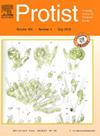Morphology and phylogeny of Prorocentrum venetum Tolomio & Cavolo (Dinophyceae)
IF 2.1
3区 生物学
Q4 MICROBIOLOGY
引用次数: 0
Abstract
Prorocentrum venetum was one of the first species of the genus Prorocentrum described by scanning electron microscopy by Tolomio and Cavolo in 1985. Since the first observation of the species in the Venice Lagoon (Italy) in summer 1981, it has not been reported again in published phytoplankton records of Mediterranean waters or elsewhere. Two strains were isolated from a French Mediterranean lagoon, which were morphologically identified as P. venetum by microscopy. Based on rDNA sequences (spanning the 18S to the D3 region of 28S rDNA), the phylogenetic analysis demonstrated that P. venetum belongs to the same clade as Prorocentrum triestinum and Prorocentrum redfieldii. The analysis of scanning electron micrographs provided an in-depth morphological description of the theca, particularly on the pore pattern of thecal plates and new structural details of the platelets in the periflagellar area. These morphological characteristics were compared with the closely related species within the P. triestinum clade, which showed synapomorphic characters in the periflagellar area (small accessory pore, platelet pattern, shape of the apical wing). Further comparison of characteristics varying between species in this clade and in the sister clade encompassing species related to Prorocentrum micans suggests some features of morphological evolution within this part of the genus.
龙足科原中央兽类的形态与系统发育
proorocentrum venetum是Tolomio和Cavolo于1985年通过扫描电子显微镜发现的proorocentrum属植物之一。自1981年夏天在威尼斯泻湖(意大利)首次观察到该物种以来,在地中海水域或其他地方发表的浮游植物记录中没有再报道过。从法国地中海泻湖分离出两株,镜检形态鉴定为威尼斯假单胞菌。基于rDNA序列(从18S到28S rDNA的D3区),系统发育分析表明,P. venetum与proorocentrum triestinum和proorocentrum redfieldii属于同一支系。扫描电镜分析提供了对鞘膜的深入形态学描述,特别是鞘板的孔隙模式和鞭毛周围区域血小板的新结构细节。这些形态特征与近缘种在鞭毛周围区(小副孔、血小板图案、顶翅形状)表现出突触性特征进行了比较。进一步比较这一分支中不同物种之间的特征差异和包含micans原中心心相关物种的姊妹分支表明,这部分属的一些形态进化特征。
本文章由计算机程序翻译,如有差异,请以英文原文为准。
求助全文
约1分钟内获得全文
求助全文
来源期刊

Protist
生物-微生物学
CiteScore
3.60
自引率
4.00%
发文量
43
审稿时长
18.7 weeks
期刊介绍:
Protist is the international forum for reporting substantial and novel findings in any area of research on protists. The criteria for acceptance of manuscripts are scientific excellence, significance, and interest for a broad readership. Suitable subject areas include: molecular, cell and developmental biology, biochemistry, systematics and phylogeny, and ecology of protists. Both autotrophic and heterotrophic protists as well as parasites are covered. The journal publishes original papers, short historical perspectives and includes a news and views section.
 求助内容:
求助内容: 应助结果提醒方式:
应助结果提醒方式:


